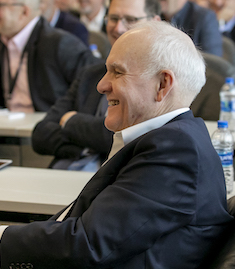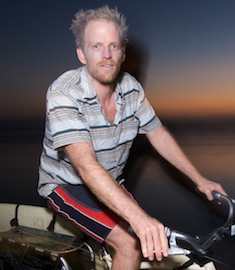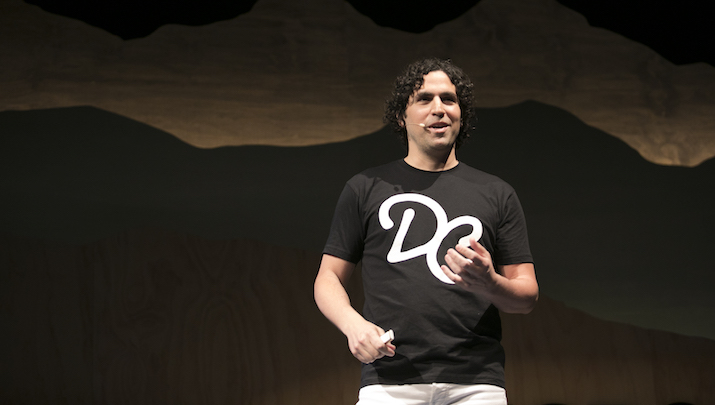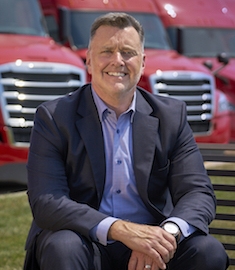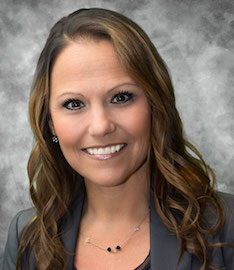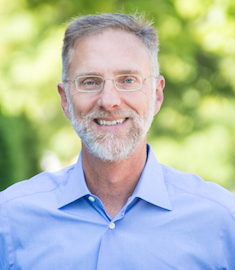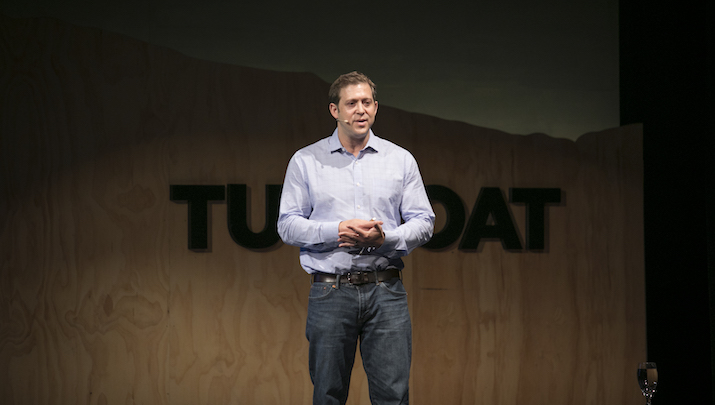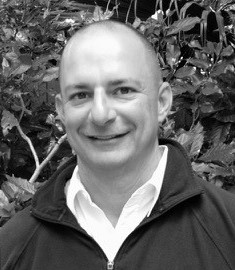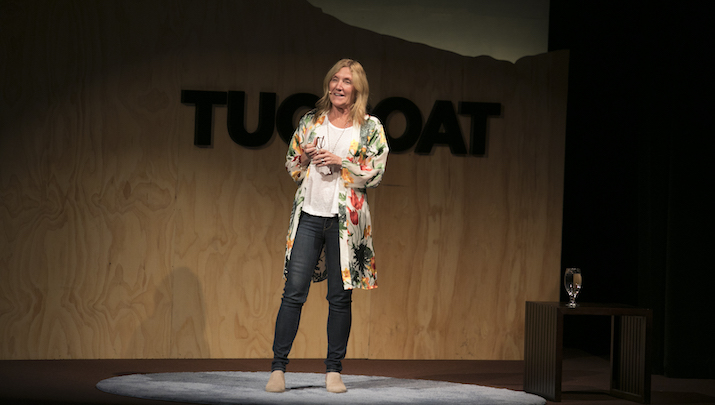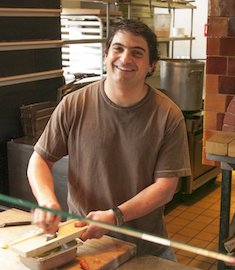Under the Hood of the Remarkable Enterprise Holdings
When Andy Taylor, Executive Chairman at Enterprise Holdings, was a young boy, his father Jack Taylor took him along to work on Saturdays at Executive Leasing, the business he owned within a St. Louis car dealership. Spending time at the dealership with his father, Andy observed early and often the spirit of fun and entrepreneurship that drove Jack and characterized the business he built.
In the candid stories that Andy generously shared during the two days he hosted Tugboat Institute @Enterprise at his headquarters last week, the Evergreen leader noted that among other essential learnings he benefitted from as he grew up in the family business, a key encouragement of his father was: “Every day is going to be fun.” Listening to Andy, it was clear that having fun has been an essential part of his and his team’s journey scaling Enterprise from $78M to a now $24B global business.
During his fireside chat with Tugboat Institute founder and CEO Dave Whorton, Andy graciously provided an in-depth look at the history of the company and of his tenure, from his days as a 16-year-old washing cars and riding along on repossession missions with his father, to his appointment as president in 1980 and his current role as Executive Chairman. He shared how his dad’s founding philosophy of “take care of your customers and employees, and the bottom line will follow” continues to be the guiding philosophy of Enterprise Holdings.
In addition to his own experiences, Andy introduced Tugboat Institute members to key Enterprise leadership team members, who presented on their unmatched talent acquisition and management training programs, the evolution of their management system and incentive practices over time, the revitalization of the company’s original fleet management business, the creation and scaling of their commercial trucking division, the evolution of their global expansion approach to match global customer needs, and their approach to addressing disruption in the transportation space today.
Throughout the sessions, the strategic role of the Taylor family in the formation, growth, and success of the company—and their unwavering commitment to the business—was a consistent theme. In the final session of the event, Tugboat members heard from Andy’s daughter and Jack’s granddaughter, Chrissy Taylor, Chief Operating Officer of Enterprise Holdings, and Andy’s niece, Carolyn Kindle Betz, Executive Director of the Enterprise Rent-a-Car Foundation. As third-generation stewards of the company, the women’s deep commitment to Enterprise, the company’s employees, and the wider community of St. Louis was an inspiring example of the impact of abiding Evergreen principles in business and life. And, they have adopted the family philosophy of working hard and having fun.
The new and old deep connections between our members, built upon their alignment around Evergreen principles, were on display during our evening events, where we introduced our community to two St. Louis landmarks. On Wednesday evening, we learned about the Donald Danforth Plant Science Center’s remarkable research in solving the world’s food challenges (while tasting Clase Azul tequila), and on Thursday night we had the pleasure of touring the recently completed Gateway Arch Museum, dining in the modern facility, and taking in the stunning views of the surrounding area from the top of the iconic Gateway Arch.
On Friday morning, about 40 of our members opted to continue their learning journey by participating in the Olin Family Business Symposium at Washington University in St. Louis. Hosted by Olin School of Business Adjunct Lecturer and Tugboat friend Spencer Burke, Principal of the St. Louis Trust company, this event offered a keynote presentation by Dave Whorton and three panels consisting of local Evergreen business leaders and Tugboat members from the area and beyond. Dave and the panelists discussed the competitive advantage of Evergreen ownership and the importance of Evergreen values to business, families, and local communities.
Across the educational sessions, evening events, and more informal moments, our days in St. Louis were characterized by the inspiration, warm connections, and shared learning that defines Tugboat Institute. We are grateful to the Taylor family and Enterprise Holdings for a once-in-a-lifetime experience together.
Diana Price is the content manager at Tugboat Institute.
How Lack of Oxygen May Have Contributed to My Evergreen Longevity
Recently a good friend said to me, “You have a unique ability to hold your breath in an upside-down kayak.” He’s not wrong. I’ve spent some time underwater.
In 2006, on a kayaking expedition in South America, I had an experience in which I came out of my kayak on a notorious stretch of river—a stretch I later learned had claimed the lives of others before me. It was sobering and scary, and when I emerged from the river I thought it would be a while before I got into a kayak again. But the next day, when I walked back to look at the roiling, flood-stage section of water that nearly took my life, I sensed that I had somehow been carried. The phenomenal message was clear: You are capable of much more; you can go bigger. It was a deep moment of spiritual knowing that stayed with me.
The sensation of oxygen deprivation—whether upside down underwater in a kayak or in basic wind sprints—is intensely painful. There’s a term for the state: hypoxia. When your body is deprived of the oxygen it needs, it hurts. Over the last 20 years, I have persevered through parallel painful intensity in our Evergreen business, Xtracycle.
I have had a love affair with bicycles since childhood, when I first felt the freedom and joy of riding a hand-me-down Schwinn around our neighborhood in Tucson, Arizona. That passion and what I have learned about the transformational impact of bikes in people’s lives remains the foundation of our cargo bike company and non-profit, Worldbike, both of which I launched while a college student in the nineties.
But I’ve learned that my passion for our product can only take me so far in building a sustainable, profitable company. In truth, it’s the unending, intensive education that continues to hold my attention. I’ve always said that I like to hang out on the overhung part of the learning curve, and (maybe not surprisingly) my journey with this business has seen me continually in that position. For a long time, I took on the challenge of learning all the aspects of running the company—from finance to fulfillment to everything in between, and I tried to do it all.
And this approach kept us moving forward for quite a long time—slowly and lurchingly. After years of this effort, I decided that the market was finally ready, and I needed to take my efforts up another level—to take a deep breath and start sprinting. I remember sharing my hopes and plans for our growth with a Tugboat team member in 2014, confident and convinced we were on a trajectory to charge ahead and grow quickly. I was certain that we would hit $5M by the end of the following year.
And then the bottom fell out.
We had been working toward developing an electric bike for a long time and, in 2015, we were given the chance to be the first U.S. customer for the European-market-leading Bosch drive system. We went for it and made the investment. And once again, we were too early. Shops didn’t know how to sell such a differentiated product, and we found ourselves way over-inventoried. Panic set in. Employees left. I hit bottom. It was not good.
By the end of 2015, I was ready to quit. I was depressed. I became a tyrant in my relationships. I was miserable. It was a very, very low point for me. I sat down and said, “I don’t think I can do this anymore.”
I was again underwater and being carried down a pretty terrifying stretch of life without the benefit of oxygen. It was painful. But, as my friend noted, it turns out I have a unique ability to persevere.
I was able to step back, personally and professionally, and take stock. I started sleeping more. I began to meditate. I cut out alcohol. On the business front, I backed up and rebooted. Overwriting my historic patterns felt horribly awkward at the time, but I knew I had to persevere in establishing new habits. No matter how much “more of the same” I could muster, it plainly wasn’t going to move us forward.
I did some research and learned that many of the issues my business was facing are common to companies that reach between $1M-$3M in sales. The business hits a level of complexity that can’t be managed without implementing systems. I couldn’t do it all; I needed to bring in help.
I hired a coach, which later lead to our adoption of the Entrepreneurial Operating System (EOS), and we continue within that system to develop strategy and teamwork that help us grow in a healthy way. I’m hopeful as I look ahead now. I’ve been telling people that I feel like a farmer: I have bought the land; I have pulled the rocks; I’ve tilled the field; and now I am seeing the first few little sprigs of green. I’m optimistic, but I know we have a lot of work ahead of us before harvest.
Despite the progress we’ve made, there’s no question that this work is exhausting. We have a lot more to do. But in all that I have learned over the last 20 years of running this company—and I’ve learned a lot—the through-line has been my belief in our Purpose.
In fact it was in those darkest days of 2015 that Xtracycle’s true Purpose became clear to me— and it’s the oxygen that has fueled my fight. This may come as a surprise, but I don’t consider myself a “cyclist” any more than I consider myself a “vaccumist.” (They are both helpful tools that help me reach a specific goal, not totems of my identity.) But I do have endless passion to realize our mission: To empower people with transformational tools that move the body and spirit.
A smarter person would have quit a long time ago. But every time I have considered pursuing something easier, two things about Xtracycle have kept me in it: I believe we are making a lasting, positive difference in the world, and I’ve never found a tougher teacher.
In the same way I felt that deep knowing alongside the river years ago, I know today that I can do more, that I am being carried for a reason, and that all of us at Worldbike and Xtracycle will do great things together.
Ross Evans is the founder of Xtracycle and its non-profit sibling, Worldbike, having resurrected the cargo bike after a 100-year historical hiatus with his pioneering "longtail" design. He has attended every Tugboat Institute event since the Carmel Valley Camp Evergreen in 2014 (but admits he may have misplaced a few of the pins...).
Primacy of Purpose
Fifty percent of every sale of Double Good gourmet popcorn is donated to support children with special needs. Alongside that clear focus on making a difference is 20 years of consistent revenue growth.
In his Tugboat Institute Summit 2018 presentation, Double Good CEO Tim Heitmann describes the powerful sense of purpose that has evolved over the company’s history—and the significant period of challenge that he feared would derail the business.
Each Challenge Has Been Essential
My father started Nussbaum Transportation in 1945 with one truck. He had an eighth-grade education, but his intelligence and extraordinary work ethic led to expansion and success. If my siblings and I wanted to spend time with my dad, we spent time working in the family business.
I tell people that my involvement with the business truly started at ground level—I cleaned bathrooms, performed maintenance work, washed trucks, and worked the dock throughout my teenage years. I loved it all: the physical nature of the work suited me, and I loved working with the big and powerful trucks. I learned a lot as I worked alongside my dad, but his most consistent message to us was: “If you take care of your people, everything else will take care of itself.”
The problem was, when I stepped into an operations role at age 19 after driving our trucks right out of high school, the people picture presented a challenge. We were a unionized company at that time, and many aspects of that environment frustrated me. I got tired of the entitlement and what I felt was an abuse of power I saw in that model; so, though we had good employees and I felt loyalty toward all that my family had built, I decided that spending my years working in a unionized business was not what I wanted to do.
I left Nussbaum Transportation in 1989 to start my own business. While I had a burning desire to venture out on my own, I didn’t do enough research ahead of time, I didn’t know my market, and I failed miserably. I went back to the family business after that misadventure, and it was a very humbling experience to return. Our employees accepted me back, as they saw my return as a sign that the business had a future. However, despite my love for those loyal employees, my heart still wasn’t there.
After a year, I determined that if I was going to be successful, I needed a formal education. I pursued a bachelor’s degree in International Business and Business Management and then went on to do a Master’s in International Management.
I got out of school and took a job as the VP of Marketing at a small company in Indianapolis that had the North American market for large format digital color ink jet printers that had the capability to produce truck/trailer graphics. This job became very frustrating due to the ethics of the company, and I desperately sought direction for my next step. Should I stay? Should I return to the family business? With these questions in mind, I sat at my desk on a Monday morning and said a prayer: “Lord, you know that if I’m going to go back, you’re going to have to make this really clear to me.” Within five seconds, a truck from our family business, emblazoned with our logo, rolled by my office window. I was headed back.
As I stepped back into the family business, we were facing significant challenges. We had started a non-union trucking company while I was away, and we were now running both that business and the unionized business. Despite creating that second, non-union company, the unionized company was struggling to compete in a non-union industry with lower operating costs. Shortly after I returned, I was approached by our general manager who wanted to purchase the non-union business. Although it was the most profitable of the two, I sensed God telling me to sell it. We went through with the sale, and I now found myself tasked with turning around a long-time unionized trucking company, operating marginally with huge legacy costs.
The next few years presented many tests in Perseverance, as we attempted to sell our LTL (less than truckload) division in response to the growing presence of box stores, which required truckload deliveries. We were not able to sell the LTL division, though, and were forced to inform our employees that we could no longer afford to keep it open. The layoffs that resulted were devastating to me. We kept our TL (full truckload) division and began rebuilding, still burdened by union operating costs, and founded another non-union trucking company, which we grew while simultaneously shrinking the unionized company. In 2008, the drivers of the unionized company decided that they wanted to get out of the Teamsters Union and took it upon themselves to gather enough votes. By an overwhelming majority, they ultimately voted the union out, and we combined both companies.
While this was a very challenging period, it was also one in which I was able to recognize that my return to the family business was an opportunity to pursue my Purpose. I had sensed a calling to missionary work throughout my adult life, but, until this time, this deep-seated desire had felt in conflict with my obligation to the family business. Once I returned, however, I came to realize that God wanted our business to become a mission. We began tithing monthly and operating our company on Biblical principles. This included a revision of our website to help visitors understand our beliefs, our mission, vision, and values (honoring God, being good stewards of His provision). Finally, we also began installing full-wrap trailer graphics depicting family scenes on our trucks to help the traveling public understand what we held most important—faith and family.
In our business, our definition of family includes our employees. Harkening back to my father’s belief that if you take care of your employees, everything else will follow, we have continued to build our company from that People First foundation. Another piece of advice he offered has guided me—he said, “a business owner doesn’t have to know how to do everything, he or she just needs to know how to hire good people.” Today, we follow that principle as we seek out employees who first have character and integrity and are bright and coachable; experience comes second to these qualities for us.We can teach them what they need to know about our business and industry.
Our People First approach has resulted in driver turnover that is a fraction of the industry average. And, this year, we followed our commitment to our employees by completing a partial ESOP. Our plan is to be 100 percent employee-owned in three years.
As I reflect on my return to the family business and the years that have followed, the message that emerges clearly to me is that in God’s economy, nothing in life is wasted. Each challenge and stage of my journey has been essential: First, I learned to pray and listen for His answer. Trying to start my own business and failing taught me humility. Going back to school gave me a foundation. Had I not taken the job in Indianapolis, I would not have learned about trailer graphics and how important a role they would play in conveying our company values. Shutting down a division and putting a couple of hundred people out of work was the most difficult thing I’ve done in my career, but it taught me empathy and to care for others.
At the end of the day, prayer, Perseverance, faith, and a deep, abiding trust in God have been the reasons for our 73 years of success. It is our hope and plan to reach 100 years!
Brent Nussbaum is CEO of Nussbaum Transportation Services, Inc.
Solving for Success
As CEO and President of Contra Costa Medical Career College, I spend my days focused on higher education and serving students. But when I left high school, I could only dream of maybe one day going to college. Though I had done very well in school as a younger student and was especially interested in and excelled in the sciences, a dysfunctional family situation and related circumstances left me without direction, support, and energy to focus on my academic life.
But even as I made the decision to enter the workforce rather than college, I was aware that if I wanted sufficient income and the stability that my upbringing had not offered, I would need some type of professional training.
With that in mind, I took a job in a dental office and became certified as a dental assistant. Looking to advance in that role, I then sought further education to become a dental hygienist. This next step required that I successfully complete prerequisite science courses at the local community college, which I did. Even with a 3.8 GPA and practical experience, the competition for a seat in the dental hygiene training program became a roadblock. The scarcity of training programs had led to the creation of a lottery system for entry, in which 25 slots were made available each year for 500 applicants. I made multiple attempts over seven years before finally deciding to choose a new path.
I opted to pursue nursing instead, which launched me into another challenging application and training process. Finally, after what was ultimately 10 years in junior college from the beginning of my journey to apply to dental hygiene programs to the completion of my RN degree, I began what would be a 13-year career as a labor and delivery nurse.
My experience of continually coming up against challenges and roadblocks to training for allied health professionals—and, on the flipside, once employed in the medical field recognizing the scarcity of well-trained employees to fill those roles—revealed a broken system. Limited points of entry to training programs, wide-ranging curriculums that required students take unnecessary courses, ever-increasing tuition costs that lead to high drop-out rates and student debt, and, often, lack of placement in their chosen field were limiting opportunity for students.
But if my personal life and professional path had taught me anything, it was the ability to confront obstacles, find Pragmatic Innovations and act with Perseverance to find a way forward. In this case, the problem was a big one: the educational system for allied health professionals needed to be reformed. I saw the opportunity to start a small school and develop accessible, targeted, and efficient training programs for entry-level healthcare professionals. We would strip away many of the obstacles to vocational training, while maintaining high standards in education and ensuring placement of graduates.
I got to work. With the idea to start with one program—phlebotomy—I contacted the state, started filling out necessary applications, and developed curriculum. I wrote a 180-page business plan and mortgaged our family home to secure funds to start the business—all while continuing to work full-time as a nurse and trying my best to spend quality time with my family. In 2007, two years after I began my research and planning, I received approval and opened the doors.
Contra Costa Medical Career College started with three programs and a combined 12 student enrollment, in a tight 2,500 square-foot facility. Ten years on, we offer 12 Allied Health Education programs and are operating in a 26,000 square-foot state-of-the-art facility. I have plans to open additional campuses in California as well as in New Mexico and Arizona. We graduated a little over 1,200 students in 2017, and we hold National Institutional Accreditation through the Accrediting Council for Continuing Education and Training and National Programmatic Accreditation through Accrediting Bureau of Health Education Schools (ABHES). We are approved by the US Department of Education to offer Title IV Funding to our students.
As our Evergreen business grows, my purpose is to continue to serve our students by providing high-quality training and education at a reasonable cost in a reasonable time frame. I know the burden in time and cost of training and the desire to take care of your family. That’s my own story. Our programs are filling a need among a very specific group of students who, like myself, in most cases are not going to pursue a four-year degree and are facing financial constraints. Often, they are raising families while working and going to school. Many are the first in their families to graduate from high school. Our programs offer an opportunity for these students to advance and achieve in spite of what are, in the traditional higher education and vocational training landscape, significant obstacles.
How do we make it work for these students? We had to innovate in three key dimensions: access, cost, and job placement.
Access
Our admission process involves in-depth interviews to ensure our students are committed and are aware of the requirements and reality of the jobs for which they are training. We drug screen, do a pre-employment background check, and require the applicants to have a high school diploma or GED prior to registration. We provide flexible course scheduling that offers instruction on weekends and weeknights to accommodate our students’ needs.
Cost
Many schools offering allied health programs and certifications charge $20K or more for a 10-month program for a job that will pay $10-$15 per hour. Students often leave with huge loan debt and can’t find a job. There is no reward at the end for them. We have built the same exact programs with the same certification outcomes, for a lot less. For example, we offer a Clinical Medical Assistant Program that costs $3,200 for 14 weeks of didactic, laboratory, and clinical externship training. This program is not eligible for government funding because it is too short, so most students pay cash. In some cases, students receive partial Pell Grants or funding from other third-party payers, but they do not take out loans. That means that, first, they have skin in the game and are committed to completing their courses; second, it means our programs are relatively short, which also contributes to our very high completion rates; third, it means they aren’t graduating burdened by debt.
Placement
Our job placement rates are outstanding because we keep the cohorts relatively small to be sure we can provide the best possible opportunities for graduate placement. We also maintain very close relationships with our clinical partners who consist of major healthcare facilities and organizations, hospitals, surgery centers, urgent care clinics, pharmacies, specialty and family practices, and non-profits in our community, which provide a consistent funnel of opportunities for our graduates. We also dedicate significant staff to our career services department to ensure our students are mentored and directed to good opportunities.
As we continue to expand and improve our programming, I put myself in the shoes of my students every day. I am constantly asking myself: How would I feel if I were the student? And, as I answer that question and encounter new challenges, we will continue to solve for their success.
Stacey Orozco is the Founder and CEO of Contra Costa Medical Career College, Inc. After a 13-year career as a labor and delivery nurse, Stacey founded Contra Costa Medical Career College to provide quality, affordable vocational education and training for allied health professions.
Accelerating Gender Diversity
In the technology industry, and in computer science specifically, awareness of gender diversity is a hot topic. I was aware of the issue 10 years ago as I exited the academic world, where it was being actively discussed. Though I had a bit of a head start on awareness when I stepped into business, it wasn’t until I committed to making gender balance a priority and took specific actions toward that goal that I was able to truly make progress.
Our first attempt failed. In 2006, about five years into the life of my software development and design company, Atomic Object, I looked at my team and said, “We’re a bunch of guys, and we need to fix that. We need to hire women developers.” But mine was a young company at the time, and I didn’t do a good job of explaining why we needed to do that. So, facing push-back from others in the company, the issue stalled. We talked a lot about it, but we didn’t succeed in hiring even one woman as a developer. We remained at around 7-10 percent female employees for years.
Then, around five years ago, I finally said, “enough is enough.” This time around, we did things differently: we created a consistent, company-wide, focused conversation around the topic across our communication platforms; we tracked our progress; we made structural changes to compensation and benefits to become more appealing to women; we modified our hiring, diversity, and marketing collateral; we reached out internally and externally to make employees and the broader community aware of our commitment to gender balance.
The results have been pretty great: today, 23 of our 65 employees are women—that’s 35 percent of the company. And, 37 percent of our developers are women.
The steady progress has been consistent as we have continued to embrace gender diversity, but our Accelerator Program, a professional development program for newly-graduated developers, has propelled us even further, faster and gives me great hope for the future of sustainable gender balance on our team.
I think there are a few key reasons the Accelerator Program has served to boost the number of women at Atomic Object. First, the program is broadly appealing to young graduates, men and women, because it bridges the gap between their academic education and on-the-ground training as a developer, where they rotate through client projects and learn many skills they never encountered in school. Second, I think young women developers are drawn to the fact that participants enter the program as part of a cohort of 3-5, which means that they are joining the company with peers—and other women—who are the same age and at the same point in their professional lives. Finally, the structured mentorship within the program, which offers young people valuable, dedicated guidance, has also created great traction for the program among women.
As we have welcomed more women into our company through the Accelerator Program, our earlier commitment and ongoing work around gender balance has served us well. Because we had already made changes to be more attractive to women before we launched the Accelerator Program, we didn’t have obstacles to overcome when our goals began to become reality.
So, what does that reality look like? What are the benefits of these efforts? Atomic Object is a more interesting, welcoming place to work. We’re able to recruit more women and have become an employer of choice in an extremely tight job market because we are viewed as a balanced, positive environment. And, while we have always been an unusually profitable company for our industry—our margin is 2-3 times the industry average—the increased number of women on our team contributes to our ability to defend and maintain our good long-term financial health. The cognitive diversity among our gender diverse team leads to increased innovation, as well as better problem solving for clients, all of which contribute to our overall strength and resilience for the long-term.
All that said, there’s no question we still have work to do. We still don’t have any senior-level women developers—though not from lack of trying. The reality is that the shortage of women in computer science is not only a pipeline issue; women also leave computer science careers at greater rates than men do, so there are just very few women in these positions. This means our young women developers lack role models, something they struggle with. In response, I encourage them to look beyond senior developers, to seek out mentorship opportunities from colleagues in different departments who can be equally helpful. I also emphasize to these young women that they will be those mentors they are seeking one day.
I look forward to continuing to contribute to making that day a reality—sooner than later.
Carl Erickson, PhD is the CEO and Co-Founder of Atomic Object, a Michigan-based software design and development company. He is also an active angel investor and managing director for Tappan Hill Ventures, has served on the boards of several tech startups, and launched his professional life as a Professor of Computer Science at Grand Valley State University.
The Competitive Advantage of Evergreens
How does ownership of a company affect its ability to compete—for better or for worse? With a professional background that spans 20 years and includes consulting roles with Fortune 500 companies, the philanthropic sector, and family businesses, BanyanGlobal Partner and Co-Founder Josh Baron is uniquely qualified to answer that question.
In his Tugboat Institute Summit 2018 presentation, Josh describes the sustainable, competitive advantage of Evergreen businesses in this century, the survival strategies that will allow Evergreens to make the most of that advantage, and why he feels these businesses can make a dent in the universe.
An Unexpected Gift of the Recession
My core Evergreen business, Spraggins Inc., is a building products and construction services company based in Orlando, Florida and focused on the contract residential market. In 2007, the great recession hit our business extremely hard. Homebuilders just stopped building.
By the fall of 2008, we were down to 17 employees from 135. The 17 employees who remained were the best, and they were successfully managing what business we had. At that point, while I had enough money saved to fund my family’s expenses, I had no cash to invest. What I did have was time.
The week of Thanksgiving, I got a call from my friend Peter Greer, who runs Hope International, a microfinance organization that does work in Africa. He wanted to take what he had learned in microfinance and deploy it in the healthcare sector in East Africa to fill a much-needed gap in healthcare access and delivery, specifically among rural communities in Burundi. The idea really resonated with me.
With time on my hands and the desire to dig into meaningful work, I told him I was in. Did I know anything about healthcare? No. Had I ever launched a nonprofit organization? No. But I did have entrepreneurial spirit, deep knowledge of business, and a faith-driven purpose to love my neighbor and to serve.
We got to work devising our plan, and we decided our core mission would address pharmaceutical distribution, which we determined was the most significant constraint.
Our first move was to go visit David Weekley, who, through his nonprofit, The David Weekley Foundation, was already dedicated to supporting healthcare efforts in Africa. The visit proved a critical eye-opener. After listening to Peter and me describe my idea, David looked at me and asked: “How many times have you been to Burundi?”
It was the right question. I hadn’t been there even once.
We put together a small team and started spending time in Burundi. Once on the ground, we engaged in some foundational market research and asked: Who is the customer? What does the customer want? If current services and resources were not meeting the need, we needed to innovate. And, more specifically, it was clear that if we wanted to address access and care in the rural population, where the greatest need existed, we needed to get out into the countryside and start asking questions and observing. When we did, we finally understood the issue.
It turns out, the main constraint in healthcare delivery in Burundi, and in much of sub-Saharan Africa, was not, as we had thought, with pharmaceutical distribution but rather at the point of patient contact: there were systemic problems that created dangerous mistakes in patient care. This was because of a lack of basic training among health workers and facility managers; they did not have access to the knowledge or tools they needed to care well for their communities. As I began to understand the scope of the limitations at health facilities, I recognized that these were actually simple problems that even I, with absolutely no expertise in healthcare, could help solve. It was about addressing basic processes, systems, and operational issues.
Pivoting from our initial focus on pharmaceutical distribution, we made the decision to engage in conversion franchising—converting existing health centers in rural communities to franchisees of our system, implementing medical training and business management training, teaching management of pharmaceutical and equipment supply, and providing quality assurance to build on existing local strengths to maximize impact.
Over the course of the next year, we tried three different conversion franchise models: we partnered with government, private, and faith-based health centers. At the end of that year, the faith-based health centers proved the best partners: they were motivated to earn enough income to sustain their work, but rather than being driven solely by profit, they were also motivated by care for their communities. We had landed on what would be our winning model: conversion franchising for church-based health centers.
Today,LifeNet International is thriving through this leveraged approach to philanthropy. Our services are donation driven, and we are operating with leverage because we’re overlaying our work on top of existing assets in health centers. This innovative design has allowed us to build a scalable, efficient model to change health outcomes—and, it’s one we can take Africa-wide. Currently, LifeNet International partners with 120 faith-based health facilities across Burundi, DRC, Uganda, and Malawi.
Ten years on from my decision to commit to LifeNet, it remains a gift of the recession. If we hadn’t experienced the downturn that offered me time and space to commit to the project, I would not have been able to take on this work. And, as we emerged from the recession, and Spraggins Inc. has grown and diversified, I have been able to bring lessons of innovation and inspiration learned through the nonprofit world into my business. My expectations have been raised for both people and operations, and my business is better for it.
Michael Spraggins is CEO of Spraggins Inc., a builder services company based in Orlando, Florida. He has held principal roles in a variety of entrepreneurial and investment ventures with an emphasis on distribution, service, and franchising. Michael founded LifeNet in 2009 with the vision of making quality healthcare an enduring reality for the world’s poor.
The Big Future of Small Town History
What do you envision when you picture idyllic small-town life? Beautiful historic buildings? A walkable downtown core filled with thriving businesses? Connected neighbors and a vibrant sense of civic pride?
All of these points are goals for Amy Simmons, founder of Amy’s Ice Creams, and her husband, who have been revitalizing the town of Smithville, Texas. As they work with other community members and encourage outside investment, their hope is to offer opportunity, encourage entrepreneurship and make lasting, positive, sustainable change. In her Tugboat Institute Summit 2018 presentation, Amy shares the Smithville story and her observations about the joy—and challenge—of revitalizing a small town.
Our Purpose is Our People
When I stepped back into the restaurant business in my mid-twenties after nine months as a staff auditor with Arthur Andersen, I thought I was taking the easy road. After years of working in restaurants through high school and college, I had followed my dad’s advice to find a job in accounting. As a career IRS agent, he always told me that an accounting degree would guarantee me a job. But early on in my time as an auditor, I knew my heart wasn’t in it. I missed the energy and community in the hospitality world.
What I quickly realized after leaving my accounting job and taking a position as an assistant manager of a café in San Francisco, was that this path was anything but easy. Managing a restaurant staff means managing people whose education, cultural, professional, and language experiences are incredibly diverse. In place of my college accounting degree, I found myself wishing I had an advanced degree in psychology.
But, today, as owner of three Bay Area restaurants—Nopa, Nopalito, and Liholiho Yacht Club—those same challenges are what inspire me every day. The opportunity to bring people with such wide-ranging backgrounds together to deliver food and drink and create incredible experiences for our guests is magic.
Building a successful team of people who are capable of making that magic happen has become my Purpose. Our most important investment is the time and training we offer our employees; if we do that right, if we develop people with the skills, knowledge, and experience to deliver truly exceptional food service, our success as a business will follow.
In our restaurants, the process of building that team starts with the way we hire our people. Resumes and past professional experience are generally not the first thing I look at. The fact is, you don’t need a college degree—or even a high school education—to be a great food service employee. If you’re curious and committed, you can learn everything you need to know on the job. So, when I interview a potential employee, I pay attention to how they engage. Do they look me in the eye? Do they shake my hand? I think if you give someone an opportunity, if you look at them not from experience but who they are as a human being, if you give them a chance, you will find people who are as invested in your business as you are in their success.
After each interview, we ask each candidate to come in and work a paid shift; after that, we conduct a second interview. My partners and I interview and then provide orientation for every hire in the restaurant. It’s so important that staff know who we are and what we do—and that I know who they are because they are reflecting our attitude toward the guests.
As staff step into their roles, we continue to educate and mentor. I don’t want to just teach someone to ring in the food and take the money and go home. I want managers to constantly be listening and educating and feeling empowered to help our employees grow. This approach is reflected in the fact that our employees tend to stay around—85 percent of our managers formerly served as staff. They are happy to come to work, and our guests feel that. They tell us, “everyone who works for you is really nice; everyone really seems to enjoy working here.” I don’t’ think you can pull the wool over your guests’ eyes. If you’re not practicing these things with your staff, you guests will see that.
In the daily experience at our restaurants, the effort we extend toward our employees creates great experiences for our guests. And it does take effort—you have to commit to educating and empowering your staff, and your management has to believe in it. It takes time. And it matters every day.
My hope is that, in the bigger picture, this daily practice and the way this People First approach is ingrained in our culture will also help employees recognize the opportunity for a fulfilling, long-term career in food service. I want our industry to be viewed as more than a stopping ground—a means to pay for school or provide flexibility. To this end, we provide 401K with a four percent match and medical benefits. I try to impart to staff that this can be a career. Given the changing tip structure and increasing attention among restaurant management to finding middle ground between front-of-house and kitchen pay structure, my sense is that we are going to see changes in how people approach working in restaurants—and how we, as owners and managers, will need to respond. I hope that our continued investment in culture and training will help us maintain success in this changing landscape.
At the end of the day, the reality is that profitability for restaurants is slim. I know that my investment in my staff and in developing a culture that empowers happy, fulfilled employees will mean our noncontrollable expenses will be lower. I might spend more money up front, but over the long term, I will have better product, less breakage, and lower turnover—all things that can chip away at the bottom line. Ultimately, everything we do to honor, engage, and educate our staff will make a difference.
There is no question that restaurant work is hard work. It’s not the easy road I envisioned when I stepped away from the corporate world—but, for me, it’s so much more fulfilling. I love what I do, and I am grateful for the opportunity to share my passion for food and hospitality with the wonderful, quirky, talented, and interesting people who come together in our restaurants each day.
Jeff Hanak is co-owner of Nopa, Nopalito, and LihoLiho Yacht Club restaurants in San Francisco.
